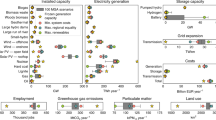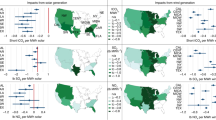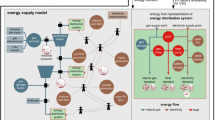Abstract
The transition to net-zero emissions in Europe is determined by a patchwork of country-level and European Union-wide policy, creating coordination challenges in an interconnected system. Here we use an optimization model to map out near-optimal energy system designs for 2050, focusing on the planning flexibility of individual regions while maintaining overall system robustness against different weather years, cost assumptions and land-use limitations. Our results reveal extensive flexibility at a regional level, where only few technologies (solar around the Adriatic and wind on the British Isles and in Germany) cannot be substituted. National policymakers can influence renewable energy export and hydrogen strategies significantly, provided they coordinate this with the remaining European system. However, stronger commitment to solar in southern Europe and Germany unlocks more design options for Europe overall. These results on regional trade-offs facilitate more meaningful policy discussions that are crucial in the transition to a sustainable energy system.
This is a preview of subscription content, access via your institution
Access options
Access Nature and 54 other Nature Portfolio journals
Get Nature+, our best-value online-access subscription
27,99 € / 30 days
cancel any time
Subscribe to this journal
Receive 12 digital issues and online access to articles
118,99 € per year
only 9,92 € per issue
Buy this article
- Purchase on SpringerLink
- Instant access to full article PDF
Prices may be subject to local taxes which are calculated during checkout






Similar content being viewed by others
Data availability
Links to data used in this article are available via GitHub at https://github.com/koen-vg/enabling-agency/tree/v0; all data used are open access (various licences).
Code availability
The code used to reproduce the results of this study is available via GitHub at https://github.com/koen-vg/enabling-agency/tree/v0. All code is open source (licensed under GPL v3.0 and MIT).
References
Regulation (EU) 2021/1119 of the European Parliament and of the Council of 30 June 2021 establishing the framework for achieving climate neutrality and amending Regulations (EC) No 401/2009 and (EU) 2018/1999 (‘European Climate Law’) EUR-Lex http://data.europa.eu/eli/reg/2021/1119/oj/eng (2021).
Communication from the Commission to the European Parliament, the European Council, the Council, the European Economic and Social Committee and the Committee of the Regions: the European Green Deal. Communication COM/2019/640 (European Commission, 2019); https://eur-lex.europa.eu/legal-content/EN/TXT/?uri=celex:52019DC0640
Hofbauer, L., McDowall, W. & Pye, S. Challenges and opportunities for energy system modelling to foster multi-level governance of energy transitions. Renew. Sustain. Energy Rev. 161, 112330 (2022).
Shu, D. Y. et al. Overcoming the central planner approach—bilevel optimization of the European energy transition. iScience https://doi.org/10.1016/j.isci.2024.110168 (2024).
Kendziorski, M., Göke, L., von Hirschhausen, C., Kemfert, C. & Zozmann, E. Centralized and decentral approaches to succeed the 100% energiewende in Germany in the European context—a model-based analysis of generation, network, and storage investments. Energy Policy 167, 113039 (2022).
Durakovic, G., del Granado, P. C. & Tomasgard, A. Powering Europe with North Sea offshore wind: the impact of hydrogen investments on grid infrastructure and power prices. Energy 263, 125654 (2023).
Strambo, C., Nilsson, M. & Månsson, A. Coherent or inconsistent? Assessing energy security and climate policy interaction within the European Union. Energy Res. Soc. Sci. 8, 1–12 (2015).
DeCarolis, J. F. Using modeling to generate alternatives (MGA) to expand our thinking on energy futures. Energy Econ. 33, 145–152 (2011).
Neumann, F. & Brown, T. The near-optimal feasible space of a renewable power system model. Electr. Power Syst. Res. 190, 106690 (2021).
Pedersen, T. T., Victoria, M., Rasmussen, M. G. & Andresen, G. B. Modeling all alternative solutions for highly renewable energy systems. Energy 234, 121294 (2021).
Grochowicz, A., van Greevenbroek, K., Benth, F. E. & Zeyringer, M. Intersecting near-optimal spaces: European power systems with more resilience to weather variability. Energy Econ. 118, 106496 (2023).
Neumann, F. & Brown, T. Broad ranges of investment configurations for renewable power systems, robust to cost uncertainty and near-optimality. iScience 26, 106702 (2023).
Pickering, B., Lombardi, F. & Pfenninger, S. Diversity of options to eliminate fossil fuels and reach carbon neutrality across the entire European energy system. Joule 6, 1253–1276 (2022).
Vågerö, O., Jackson Inderberg, T. H. & Zeyringer, M. The effects of fair allocation principles on energy system model designs. Environ. Res. Energy https://doi.org/10.1088/2753-3751/ad8e6a (2024).
Pedersen, T. T., Andersen, M. S., Victoria, M. & Andresen, G. B. Using modeling all alternatives to explore 55% decarbonization scenarios of the European electricity sector. iScience 26, 106677 (2023).
Sasse, J.-P. & Trutnevyte, E. Cost-effective options and regional interdependencies of reaching a low-carbon European electricity system in 2035. Energy 282, 128774 (2023).
Brown, T., Schlachtberger, D., Kies, A., Schramm, S. & Greiner, M. Synergies of sector coupling and transmission reinforcement in a cost-optimised, highly renewable European energy system. Energy 160, 720–739 (2018).
Neumann, F., Zeyen, E., Victoria, M. & Brown, T. The potential role of a hydrogen network in Europe. Joule 7, 1793–1817 (2023).
WindEurope. Wind energy in Europe: 2022 statistics and the outlook for 2023–2027. Windflix https://windeurope.org/intelligence-platform/product/wind-energy-in-europe-2022-statistics-and-the-outlook-for-2023-2027/ (2023).
Schmela, M. European Market Outlook for Solar Power 2022–2026 (SolarPower Europe, 2022); https://www.solarpowereurope.org/press-releases/new-report-reveals-eu-solar-power-soars-by-almost-50-in-2022
Eurostat. Supply, transformation and consumption of gas. Eurostat https://ec.europa.eu/eurostat/databrowser/view/nrg_cb_gas/default/table?lang=en (2023).
Department for Energy Security & Net Zero (UK). Natural gas supply and consumption. Energy Trends https://assets.publishing.service.gov.uk/media/65130c71b23dad000de706d5/ET_4.1_SEP_23.xlsx (2023).
Ressursrapport 2022 (Oljedirektoratet, 2022); https://www.sodir.no/aktuelt/publikasjoner/rapporter/ressursrapporter/ressursrapport-2022/
Eurostat. Energy imports dependency (nrg_ind_id). Eurostat (2024).
Europe’s 2040 Climate Target and Path to Climate Neutrality by 2050 Building a Sustainable, Just and Prosperous Society (European Commission, 2024); https://eur-lex.europa.eu/resource.html?uri=cellar:6c154426-c5a6-11ee-95d9-01aa75ed71a1.0001.02/DOC_1&format=PDF
Germany—Draft Updated NECP 2021–2030 (European Commission, 2023); https://commission.europa.eu/publications/germany-draft-updated-necp-2021-2030_en
British Energy Security Strategy (British Government, 2022); https://www.gov.uk/government/publications/british-energy-security-strategy
France—Draft Updated NECP 2021–2030 (European Commission, 2023); https://commission.europa.eu/publications/france-draft-updated-necp-2021-2030_en
Olje- og energidepartementet og Klima- og miljødepartementet. Regjeringens hydrogenstrategi—på vei mot lavutslippssamfunnet Report No. Y-0127 B (Norwegian Government, 2020).
Minister of Climate, Energy and Utilities of the Kingdom of Denmark, Minister for Energy of the Kingdom of Belgium, The Minister for Climate and Energy Policy of the Netherlands & The Minister for Economic Affairs and Climate Action of the Federal Republic of Germany. The Declaration of Energy Ministers on the North Sea as a Green Power Plant of Europe (2022); https://www.bmwk.de/Redaktion/DE/Downloads/Energie/20220518-declaration-of-energy-ministers.pdf?__blob=publicationFile&v=10
Sweden—Draft Updated NECP 2021–2030 (European Commission, 2023); https://commission.europa.eu/document/download/bdd2bbe5-eefd-4d22-a729-2a74cbb30e1f_en?filename=EN_SWEDEN
Denmark—Draft Updated NECP 2021–2030 (European Commission, 2023); https://commission.europa.eu/document/download/31895e48-37c3-46fe-8a8f-8f61fbff6724_en?filename=EN_DENMARK
Finland—Draft Updated NECP 2021–2030 (European Commission, 2023); https://commission.europa.eu/document/download/78c7f4bd-a3ca-4e83-8732-65f1e0d0baaa_en?filename=DRAFT
Schlachtberger, D. P., Brown, T., Schramm, S. & Greiner, M. The benefits of cooperation in a highly renewable European electricity network. Energy 134, 469–481 (2017).
Hörsch, J. & Brown, T. The role of spatial scale in joint optimisations of generation and transmission for European highly renewable scenarios. In 2017 14th International Conference on the European Energy Market (EEM), Dresden, Germany 1–7 (2017); https://doi.org/10.1109/EEM.2017.7982024
Tröndle, T., Lilliestam, J., Marelli, S. & Pfenninger, S. Trade-offs between geographic scale, cost, and infrastructure requirements for fully renewable electricity in Europe. Joule 4, 1929–1948 (2020).
Perera, M. & Tansini, C. Land for Renewables: Briefing on Spatial Requirements for a Sustainable Energy Transition in Europe (European Environmental Bureau, 2024); https://eeb.org/library/land-for-renewables-briefing-on-spatial-requirements-for-a-sustainable-energy-transition-in-europe/
Spain—Draft Updated NECP 2021–2030 (European Commission, 2023); https://commission.europa.eu/document/download/9ea170ec-fdce-49cb-9424-4ee95db33a4a_en?filename=EN_SPAIN
Portugal—Draft Updated NECP 2021–2030 (European Commission, 2023); https://commission.europa.eu/document/download/bbcdfa78-5d50-474d-bd7f-16bd804a8388_en?filename=EN_PORTUGAL
European Commission. Communication from the Commission to the European Parliament, the Council, the European Economic and Social Committee and the Committee of the Regions: A Hydrogen Strategy for a Climate-Neutral Europe Communication COM/2020/301 (European Union, 2020); https://eur-lex.europa.eu/legal-content/EN/TXT/?uri=CELEX:52020DC0301
UK Hydrogen Strategy (Secretary of State for Business, Energy & Industrial Strategy, 2021).
Fortschreibung der Nationalen Wasserstoffstrategie (Bundesministerium für Wirtschaft und Klimaschutz, 2023); https://www.bmwk.de/Redaktion/DE/Wasserstoff/Downloads/Fortschreibung.pdf?__blob=publicationFile&v=4
Seck, G. S. et al. Hydrogen and the decarbonization of the energy system in Europe in 2050: a detailed model-based analysis. Renew. Sustain. Energy Rev. 167, 112779 (2022).
Kountouris, I. et al. A unified European hydrogen infrastructure planning to support the rapid scale-up of hydrogen production. Nat. Commun. 15, 5517 (2024).
Lombardi, F., Pickering, B., Colombo, E. & Pfenninger, S. Policy decision support for renewables deployment through spatially explicit practically optimal alternatives. Joule 4, 2185–2207 (2020).
Trutnevyte, E. Does cost optimization approximate the real-world energy transition? Energy 106, 182–193 (2016).
Smith, P. et al. Biophysical and economic limits to negative CO2 emissions. Nat. Clim. Change 6, 42–50 (2016).
Heck, V., Gerten, D., Lucht, W. & Popp, A. Biomass-based negative emissions difficult to reconcile with planetary boundaries. Nat. Clim. Change 8, 151–155 (2018).
Odenweller, A., Ueckerdt, F., Nemet, G. F., Jensterle, M. & Luderer, G. Probabilistic feasibility space of scaling up green hydrogen supply. Nat. Energy 7, 854–865 (2022).
Kazlou, T., Cherp, A. & Jewell, J. Feasible deployment of carbon capture and storage and the requirements of climate targets. Nat. Clim. Change https://doi.org/10.1038/s41558-024-02104-0 (2024).
Müller, V. P., Riemer, M. & Eckstein, J. Are Carbon-Based E-Fuels a Viable Path to Decarbonization?—A Critical Comparison of Global Supply and Demand. In 2024 20th International Conference on the European Energy Market (EEM) 1–7 (2024); https://doi.org/10.1109/EEM60825.2024.10608862
de la Esperanza Mata Pérez, M., Scholten, D. & Smith Stegen, K. The multi-speed energy transition in Europe: opportunities and challenges for EU energy security. Energy Strategy Rev. 26, 100415 (2019).
Tosatto, A., Beseler, X. M., Østergaard, J., Pinson, P. & Chatzivasileiadis, S. North Sea energy islands: impact on national markets and grids. Energy Policy 167, 112907 (2022).
Harmonised indices of consumer prices (HICP)—all items (Eurostat, accessed 29 November 2023); https://ec.europa.eu/eurostat/databrowser/view/teicp000/default/table?lang=en
Pineda, S. & Morales, J. M. Chronological time-period clustering for optimal capacity expansion planning with storage. IEEE Trans. Power Syst. 33, 7162–7170 (2018).
Kotzur, L., Markewitz, P., Robinius, M. & Stolten, D. Impact of different time series aggregation methods on optimal energy system design. Renew. Energy 117, 474–487 (2018).
Brown, T., Hörsch, J. & Schlachtberger, D. PyPSA: python for power system analysis. J. Open Res. Software 6, 4 (2018).
Zeyringer, M., Price, J., Fais, B., Li, P.-H. & Sharp, E. Designing low-carbon power systems for Great Britain in 2050 that are robust to the spatiotemporal and inter-annual variability of weather. Nature Energy 3, 395–403 (2018).
Patankar, N., Sarkela-Basset, X., Schivley, G., Leslie, E. & Jenkins, J. Land use trade-offs in decarbonization of electricity generation in the American West. Energy Clim. Change 4, 100107 (2023).
Technology Data for Generation of Electricity and District Heating (Danish Energy Agency, accessed 21 September 2023); https://ens.dk/technologydata
Hörsch, J., Hofmann, F., Schlachtberger, D. & Brown, T. PyPSA-Eur: an open optimisation model of the European transmission system. Energy Strategy Rev. 22, 207–215 (2018).
German Bundestag. Gesetz zu Sofortmaßnahmen für einen beschleunigten Ausbau der erneuerbaren Energien und weiteren Maßnahmen im Stromsektor (Bundesanzeiger Verlag, 2022); https://dejure.org/BGBl/2022/BGBl._I_S._1237
Hersbach, H. et al. ERA5 hourly data on single levels from 1940 to present. Climate Data Store https://doi.org/10.24381/cds.adbb2d47 (2023).
Ireland—Draft Updated NECP 2021–2030 (European Commission, 2023); https://commission.europa.eu/document/download/4b741649-7249-47d6-b62a-b123edd49ae5_en?filename=Ireland
Electricity statistics (MW/GWh) by country/area, technology, data type, grid connection and year (IRENA); https://pxweb.irena.org/pxweb/en/IRENASTAT
Arbeitsgruppe Erneuerbare Energien-Statistik. Erneuerbare Energien in Deutschland, Daten zur Entwicklung im Jahr 2024 (Umweltbundesamt, accessed 16 April 2025); https://www.umweltbundesamt.de/publikationen/erneuerbare-energien-in-deutschland-2024
Acknowledgements
A.G., F.E.B. and M.Z. acknowledge funding by UiO:Energy and Environment (SPATUS). ERA5 reanalysis data were downloaded from the Copernicus Climate Change Service (C3S)63. The results contain modified Copernicus Climate Change Service information 2020. Neither the European Commission nor ECMWF is responsible for any use that may be made of the Copernicus information or data it contains.
Author information
Authors and Affiliations
Contributions
Conceptualization: all authors. Methodology: K.v.G. and A.G. Coding and analysis: K.v.G. and A.G. Writing—original draft: K.v.G. and A.G. Writing—review and editing: all authors. Supervision: M.Z. and F.E.B.
Corresponding author
Ethics declarations
Competing interests
The authors declare no competing interests.
Peer review
Peer review information
Nature Sustainability thanks Stathis Devves, Ioannis Kountouris, Fabian Neumann, Tim Tröndle, Marta Victoria and the other, anonymous, reviewer(s) for their contribution to the peer review of this work.
Additional information
Publisher’s note Springer Nature remains neutral with regard to jurisdictional claims in published maps and institutional affiliations.
Supplementary information
Supplementary Information
Supplementary Figs. 1–34, Tables 1 and 2, and Notes 1–6.
Rights and permissions
Springer Nature or its licensor (e.g. a society or other partner) holds exclusive rights to this article under a publishing agreement with the author(s) or other rightsholder(s); author self-archiving of the accepted manuscript version of this article is solely governed by the terms of such publishing agreement and applicable law.
About this article
Cite this article
van Greevenbroek, K., Grochowicz, A., Zeyringer, M. et al. Trading off regional and overall energy system design flexibility in the net-zero transition. Nat Sustain 8, 629–641 (2025). https://doi.org/10.1038/s41893-025-01556-2
Received:
Accepted:
Published:
Issue Date:
DOI: https://doi.org/10.1038/s41893-025-01556-2



